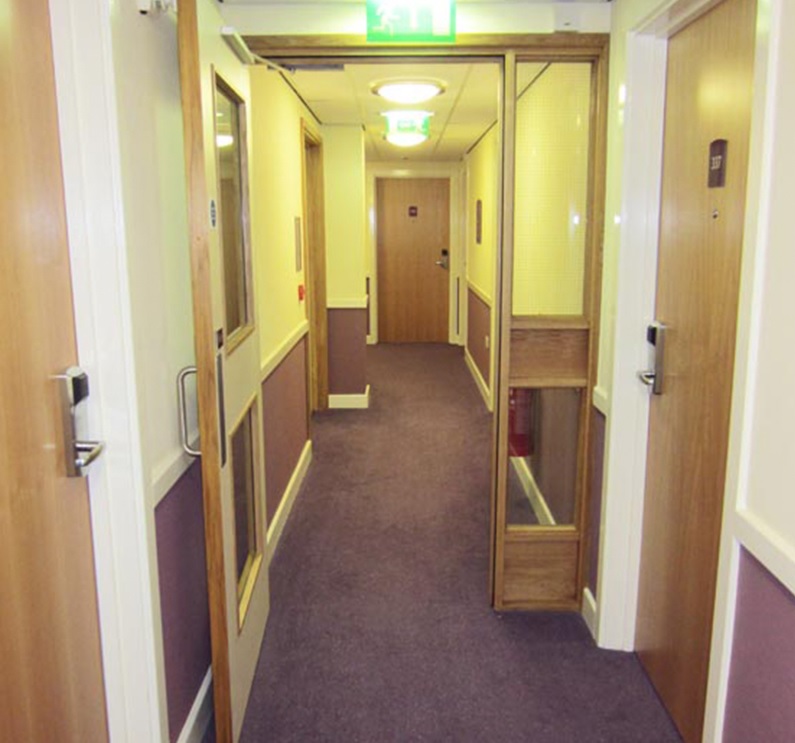How fire doors can save lives

|
Contents |
[edit] Introduction
Fire doors have proven to be invaluable when it comes to protecting buildings, belongings and people. The safety features built into these specially-designed doors can be the difference between a singed room and serious injury, or even fatalities.
[edit] Anatomy of a fire door
There are many important elements to fire doors and all need to be fully-functioning in order to provide the best protection. Ordinarily, they feature overhead door closers to ensure that they shut automatically, with intumescent and smoke seals around the frame to stop the spread of flames and contain harmful fumes that could otherwise suffocate people. The intumescent seals are designed to expand to several times their original size when exposed to heat, sealing the gap between the door and frame.
When the doors feature glazed apertures, the glass is specially manufactured to resist the sudden temperature changes and high temperatures of a fire – normal glass would quickly break or shatter when exposed to heat.
The ironmongery fitted to a fire door is as important as the door itself. Latches, locks, door closers and other items all need to be certified and compatible with the door itself, otherwise they could fail in the event of a fire.
For fire doors in public buildings, push bars or pads provide a quick exit when fires break out. Fire doors are designed to offer protection but people also need to be able to escape easily from the room that the fire is in, making sure that the door is sealed once again to slow or stop the spread of flames.
[edit] Why certain buildings need fire doors
In the majority of commercial buildings and accommodation premises (this includes blocks of flats, sheltered accommodation, houses of multiple occupancy, etc), fire doors are a legal requirement for the safety and protection of those within. When kept shut in a fire they provide proven protection to both people and property.
[edit] Importance of maintenance
While having a fire door in place can make all the difference, there is little point if it is not looked after and maintained. Like most things, a door's performance over time can deteriorate due to general wear and tear. To keep a fire door in optimum condition, it should be checked biannually. If a problem is noticed with the way the door closes, gaps forming, or any general damage, it should be repaired as soon as the problem arises.
It is also vital that fire doors are properly fitted in the first place to ensure that they function as designed. Skilled, experienced joiners who are aware of, and abide by, the installation guidelines of each doorset are the best bet. Ideally they would have third-party certification for installing fire doors.
The protection fire doors offer during a crisis is unparalleled. They save lives, even if it is only by giving individuals more time to escape. They are essential in public buildings, to lower risk factors and to keep people safe.
[edit] About this article
This article, posted in August 2019, was provided by Doorpac, a UK-based manufacturer of fire doors and doorsets.
[edit] Related articles on Designing Buildings Wiki
- A Guide for Selecting Flat Entrance Doorsets.
- Automatic release mechanism.
- Doors.
- Grenfell fire door investigation.
- Fire compartment.
- Fire detection and alarm systems.
- Fire Door Inspection Scheme.
- Fire Doors (DG 524).
- Fire in buildings.
- Fire protection engineering.
- Fire resistance.
- Free-swing door closer.
- Hold-open device.
- Installing fire doors and doorsets (GG 86).
- Means of escape.
- Protected escape route.
- The Regulatory Reform (Fire Safety) Order 2005.
- Types of door.
- Self-closing device.
- Width of doors stairs and escape routes.
Featured articles and news
One of the most impressive Victorian architects. Book review.
RTPI leader to become new CIOB Chief Executive Officer
Dr Victoria Hills MRTPI, FICE to take over after Caroline Gumble’s departure.
Social and affordable housing, a long term plan for delivery
The “Delivering a Decade of Renewal for Social and Affordable Housing” strategy sets out future path.
A change to adoptive architecture
Effects of global weather warming on architectural detailing, material choice and human interaction.
The proposed publicly owned and backed subsidiary of Homes England, to facilitate new homes.
How big is the problem and what can we do to mitigate the effects?
Overheating guidance and tools for building designers
A number of cool guides to help with the heat.
The UK's Modern Industrial Strategy: A 10 year plan
Previous consultation criticism, current key elements and general support with some persisting reservations.
Building Safety Regulator reforms
New roles, new staff and a new fast track service pave the way for a single construction regulator.
Architectural Technologist CPDs and Communications
CIAT CPD… and how you can do it!
Cooling centres and cool spaces
Managing extreme heat in cities by directing the public to places for heat stress relief and water sources.
Winter gardens: A brief history and warm variations
Extending the season with glass in different forms and terms.
Restoring Great Yarmouth's Winter Gardens
Transforming one of the least sustainable constructions imaginable.
Construction Skills Mission Board launch sector drive
Newly formed government and industry collaboration set strategy for recruiting an additional 100,000 construction workers a year.
New Architects Code comes into effect in September 2025
ARB Architects Code of Conduct and Practice available with ongoing consultation regarding guidance.
Welsh Skills Body (Medr) launches ambitious plan
The new skills body brings together funding and regulation of tertiary education and research for the devolved nation.
Paul Gandy FCIOB announced as next CIOB President
Former Tilbury Douglas CEO takes helm.






















